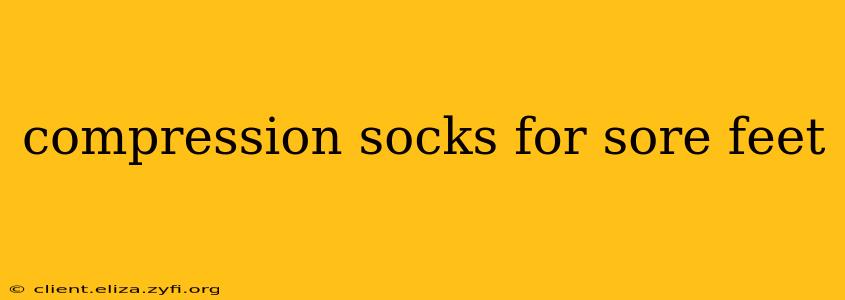Sore feet can significantly impact your daily life, hindering your ability to enjoy activities and causing considerable discomfort. While rest and proper footwear are crucial, compression socks have emerged as a popular and effective tool for managing and alleviating foot pain. This comprehensive guide delves into the benefits, types, and considerations for using compression socks to find relief from sore feet.
What are Compression Socks and How Do They Help Sore Feet?
Compression socks are specially designed hosiery that applies graduated pressure to your legs and feet. This means the pressure is highest at the ankle and gradually decreases as it moves up the leg. This graduated compression promotes better blood circulation, which is key to relieving several causes of sore feet. Improved blood flow helps to:
- Reduce swelling: Swelling (edema) is a common cause of foot pain and discomfort. Compression socks help to push excess fluid back towards the heart, reducing swelling and easing pressure on your feet.
- Improve oxygen delivery: Increased blood flow delivers more oxygen and nutrients to your foot muscles, aiding in their recovery and reducing fatigue.
- Support muscles and tendons: The compression provides gentle support to your foot's muscles and tendons, reducing strain and improving stability, especially beneficial after physical activity.
- Decrease inflammation: By improving circulation and reducing swelling, compression socks can help to lessen inflammation, a major contributor to foot pain.
What Types of Compression Socks are Best for Sore Feet?
The best type of compression sock for you will depend on the severity of your foot pain and the underlying cause. Generally, compression levels are measured in mmHg (millimeters of mercury):
- Mild Compression (8-15 mmHg): Ideal for everyday wear, travel, or mild swelling. These are often suitable for preventative measures or for individuals with minor foot discomfort.
- Moderate Compression (15-20 mmHg): Recommended for managing moderate swelling, varicose veins, and improving circulation for individuals with more significant foot pain.
- Firm Compression (20-30 mmHg): Often prescribed for managing severe swelling, deep vein thrombosis (DVT), and post-surgical recovery. These should only be used under medical supervision.
You'll find various sock lengths:
- Ankle socks: Offer compression to the ankle and lower leg.
- Crew socks: Extend to mid-calf for more comprehensive compression.
- Knee-high socks: Provide support up to the knee, offering the most extensive compression coverage.
Are Compression Socks Right for My Sore Feet?
Determining if compression socks are the right solution for your sore feet requires considering the cause of your pain. While they offer excellent relief for many foot problems, they are not a cure-all. They are particularly beneficial for conditions like:
- Plantar fasciitis: The compression can help to support the plantar fascia ligament, reducing pain and inflammation.
- Metatarsalgia: By improving blood flow and reducing swelling, compression socks can ease pain in the ball of your foot.
- Edema (swelling): Compression socks are a cornerstone of managing edema in the feet and legs.
- Post-exercise recovery: They assist in muscle recovery and reduce soreness after physical activity.
What if my foot pain is severe or persistent?
If your foot pain is severe, persistent, or accompanied by other symptoms (e.g., numbness, tingling, redness, fever), you should consult a doctor or podiatrist. They can diagnose the underlying cause of your pain and recommend appropriate treatment, which may include compression socks as part of a broader care plan. Do not rely solely on compression socks for serious foot conditions.
How to Choose and Wear Compression Socks for Sore Feet
Choosing the right compression socks involves considering your individual needs and preferences. Look for high-quality materials that are breathable and comfortable. Ensure you select the appropriate compression level based on your condition.
When putting them on:
- Sit down: This ensures proper placement and prevents strain.
- Smooth them out: Avoid bunching or wrinkles, which can restrict blood flow.
- Wear them correctly: Ensure the toes are pointing down and the pressure is highest at the ankle.
It’s generally recommended to wear compression socks during the day, removing them at night to allow for adequate rest.
How Often Should I Replace My Compression Socks?
Compression socks wear out over time, losing their effectiveness. Replacing them regularly is crucial to maintain their benefits. Most manufacturers recommend replacing them every 3-6 months, depending on frequency of use and wear.
Can Compression Socks Prevent Sore Feet?
While compression socks are excellent for treating sore feet, they can also play a preventative role, particularly for individuals who spend long hours on their feet or engage in strenuous activities. Wearing them proactively can improve circulation, reduce fatigue, and minimize the risk of developing foot problems.
This information is intended for general knowledge and does not constitute medical advice. Always consult with a healthcare professional for any concerns regarding your foot health.
